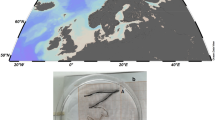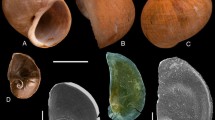Abstract
In Chinquihue Bay, a sheltered locality in Southern Chile, female Crepidula dilatata Lamarck brood egg masses which differ in intracapsular development. In some, all eggs develop and are hatched as free veliger larvae (indirect development). In others, only some of the eggs develop and hatch as young adults (direct development), the rest being consumed as nurse eggs. Two possible interpretations are considered: intrapopulation variation of developmental pattern in a species, and the coexistence of two sibling species. Stages of the intracapsular development are described and illustrated. Fecundity varies according to size of the female. For females brooding eggs with indirect development it is estimated at between 3840 and 85575 embryos per spawn; for females with eggs undergoing direct development, embryo production per egg mass is estimated at between 70 and 812. A comparison is made between females brooding the two kinds of egg masses. Minor differences exist in adult coloration, shape of egg capsules, egg diameters, spawning season and their abundance and distribution in the intertidal. Brooding females with eggs displaying indirect development are significantly larger than those with eggs of direct development. The latter females form chains subtidally but not intertidally as do females bearing eggs with indirect development. On these females with pelagic larvae, chains frequently include sedentary males which reach large sizes. On basal females with direct development, chains contain mostly other females, suggesting that matings are temporary and by errant males. These results are compared with existing information in the literature for other species both in this genus and in other marine invertebrates. It is concluded that two sympatric sibling species with different modes of development are present in the morphospecies C. dilatata Lamarck in Southern Chile.
Similar content being viewed by others
Literature cited
Amio, M.: A comparative embryology of marine gastropods, with ecological considerations. J. Shimonoseki Coll. Fish. 12, 229–358 (1963)
Chipperfield, P.N.: The breeding of Crepidula fornicata (L.) in the river Blackwater, Essex. J. mar. biol. Ass. U.K. 30, 49–71 (1951)
Clasing, E.: Sobre el hábito alimenticio de 18 especies de moluscos intermareales de Mehuin (Prov. de Valdivia, Chile) en relación a su estructura radular. Seminario curricular Lic. Zoología, Universidad Austral de Chile 1972
Coe, W.R.: Sexual phases in Crepidula. J. exp. Zool. 72, 455–477 (1936)
—: Influence of association on the sexual phases of gastropods having protandric consecutive sexuality. Biol. Bull. mar. biol. Lab., Woods Hole 75, 274–285 (1938)
—: Divergent methods of development in morphologically similar species of prosobranch gastropods. J. Morph. 84, 383–399 (1949)
Dell, R.K.: The marine Mollusca of the Royal Society Expedition to southern Chile, 1958–59. Rec. Dom. Mus. 7, 155–233 (1971)
Giglioli, M.E.: The egg masses of the Naticidae (Gastropoda). J. Fish. Res. Bd Can. 12, 287–327 (1955)
Gould, H.N.: Studies on sex in the hermaphrodite mollusk Crepidula plana. IV. Internal and external factors influencing growth and sex development. J. exp. Zool. 119, 93–160 (1952)
Hendler, G. and D.R. Franz: Population dynamics and life history of Crepidula convexa Say (Gastropoda: Prosobranchia) in Delaware Bay. Biol. Bull. mar. biol. Lab., Woods Hole 141, 514–526 (1971)
Ishiki, H.: Sex-changes in Japanese slipper limpets, Crepidula aculeata and Crepidula walshi. J. Sci. Hiroshima Univ. (Ser. B, Div. 1) 4, 91–99 (1936)
Lamarck, J.B.: Histoire naturelle des animaux sans vértebres, Vol. 7. Moll. Paris 1822
Marincovich, L.: Intertidal mollusks of Iquique, Chile. Sci. Bull. nat. Hist. Mus. Los. Ang. Cty 16, 1–49 (1973)
Mayr, E.: Animals species and evolution, 797 pp. Cambridge, Mass.: Belknap Press of Harvard University Press 1963
Menge, B.A.: Brood or broadcast? The adaptive significance of different reproductive strategies in the two intertidal sea stars Leptasterias hexactis and Pisaster ochraceus. Mar. Biol. 31, 87–100 (1975)
Mileikovsky, S.A.: Larvae (mainly of Polychaeta and Gastropoda) and spawning ecology of marine bottom invertebrates with pelagic development on the example of Barnets, White and Norwegian Seas and Gulf Stream, 2143 pp. Ph. D. thesis, Institute of Oceanology of the Academy of Sciences of the USSR 1965
—: Types of larval development in marine bottom invertebrates, their distribution and ecological significance: a re-evaluation. Mar. Biol. 10, 193–213 (1971)
Orton, J.H.: On the occurrence of protandric hermaphoroditism in the mollusc Crepidula fornicata. Proc. R. Soc. (Ser. B) 81, 468–484 (1909)
—: The mode of feeding of Crepidula, with an account of the current-producing mechanism in the mantle cavity, and some remarks on the mode of feeding in gastropods and lamellibranchs. J. mar. biol. Ass. U.K. 9, 444–478 (1912)
Parodiz, J.J.: Las especies de Crepidula de las costas argentinas. Physis, B. Aires 17, 685–709 (1939)
Rasmussen, E.: Faunistic and biological notes on marine invertebrates. II. The eggs and larvae of some Danish marine gastropods. Vidensk. Meddr dansk naturh. Foren. 113, 201–249 (1951)
—: Faunistic and biological notes on marine invertebrates. III. The reproduction and larval development of some polychaetes from the Isefjord, with some faunistic notes. Biol. Meddr 23, 1–84 (1956)
Thorson, G.: Reproduction and larval development of Danish marine bottom invertebrates, with special reference to the planktonic larvae in the Sound (Øresund). Meddr Kommn Danm. Fisk.-og Havunders. (Ser. Plankton) 4, 1–529 (1946)
—: Reproductive and larval ecology of marine bottom invertebrates. Biol. Rev. 25, 1–45 (1950)
Vance, R.R.: On reproductive strategies in marine benthic invertebrates. Am. Nat. 107, 339–352 (1973)
Werner, B.: Über die Anatomie, die Entwicklung und Biologie des Veligers und der Veliconcha von Crepidula fornicata L. (Gastropoda Prosobranchia). Helgoländer wiss. Meeresunters. 5, 169–215 (1955)
Author information
Authors and Affiliations
Additional information
Communicated by O. Kinne, Hamburg
Devoted to Dr. E.F. Kilian, Zoologisches Institut der Universität Gießen, FRG.
Rights and permissions
About this article
Cite this article
Gallardo, C.S. Two modes of development in the morphospecies Crepidula dilatata (Gastropoda: Calyptraeidae) from Southern Chile. Mar. Biol. 39, 241–251 (1977). https://doi.org/10.1007/BF00390998
Accepted:
Issue Date:
DOI: https://doi.org/10.1007/BF00390998




